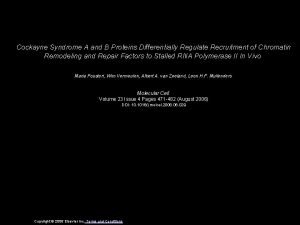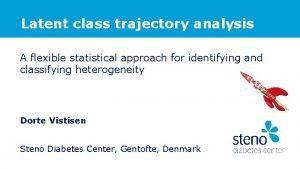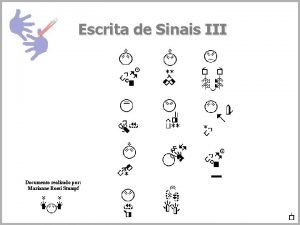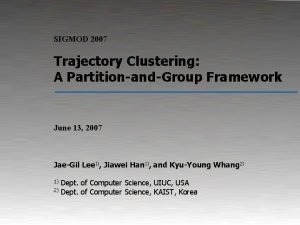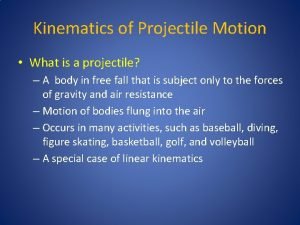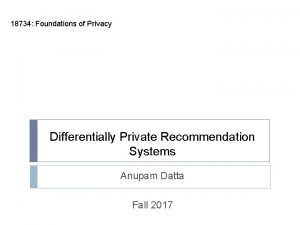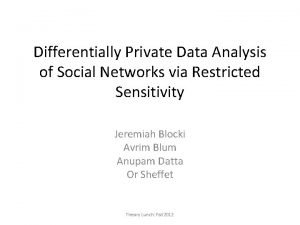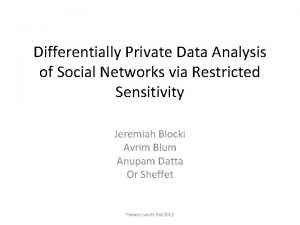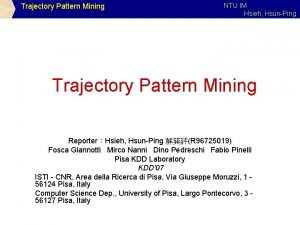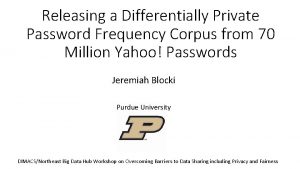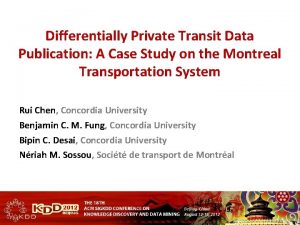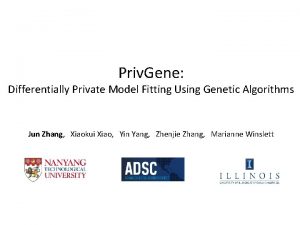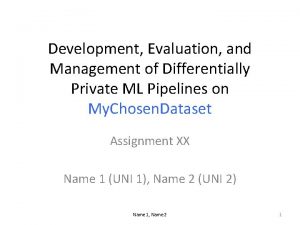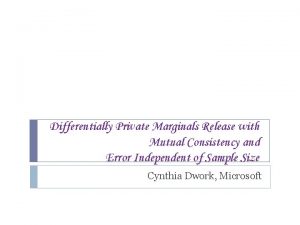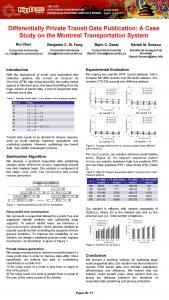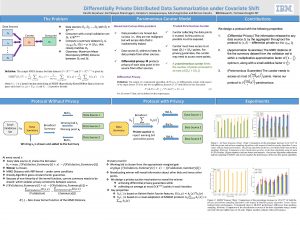Differentially Private Trajectory Analysis for PointsofInterest Recommendation Chao


























- Slides: 26

Differentially Private Trajectory Analysis for Points-of-Interest Recommendation Chao Li, Balaji Palanisamy, James Joshi School of Information Sciences University of Pittsburgh

Outline • Introduction • Concepts and model • Differential private trajectory analysis • Experiments • Conclusion

The increasing GPS market GPS Market ($ billion) 30 25 20 15 10 5 0 2011 2012 2013 2014 2015 2016 • The GPS market generated $9. 1 billion in 2011 and is expected to generate $26. 36 billion by 2016 at a CAGR of 23. 7% from 2011 to 2016.

Trajectory A trajectory represents a sequence of location information formed by a series of (latitude, longitude, timestamp) triple. A trajectory can capture a variety of travel information of the users: • user’s movement pattern • travel paths • travel destination

Trajectory-based travel recommendation Trajectories of an individual mobile user can be analyzed to understand her personal travel recommendations. The mobile users implicitly recommend their visited places to the new visitors. ‘I visited this shopping mall, it may be also worth a visit for you. ’

Trajectory-based travel recommendation Aggregate analysis of historical trajectory data belonging to different mobile users can provide more generalized travel recommendations, such as: • ‘Where are the top-10 points-of-interest in a given city? ’ • ‘Which shopping mall is the most popular in this area? ’ • ‘Which users have frequently visited this restaurant? ’

Privacy threats Although historical personal trajectory data provide immense information to generate accurate and useful points-of-interest recommendation, the exposure of the sensitive trajectory information can pose significant privacy risks that can invade the location privacy of the users.

Privacy threats In particular, the location information of the travel destination is often associated with a semantic meaning. The disclosure of the association between a mobile user and such a location may reveal private information such as the health conditions.

Differentially private trajectory analysis for points-ofinterest recommendation In this paper, we propose the privacy-preserving trajectory mining that can both: • do points-of-interest recommendation by analyzing the trajectory dataset. • protect the privacy of the exposed trajectories with differential privacy guarantees. Steps: Ø Our algorithm first transforms the raw trajectory dataset into a bipartite graph. Ø It then extracts the association matrix representing the bipartite graph to inject carefully calibrated noise to meet differential privacy guarantees. Ø Finally, a post-processing of the perturbed association matrix is performed to suppress noise prior to performing a Hyperlink-Induced Topic Search (HITS) on the transformed data that generates an ordered list of recommended points-of-interest.

Outline • Introduction • Concepts and model • Differential private trajectory analysis • Experiments • Conclusion

User-location bipartite graph representation For the purpose of points-of-interest recommendation considered in this work, the raw trajectory dataset is transformed to be processed as a bipartite graph. Five steps: Ø Raw trajectory dataset. Ø Stop points detection. Ø Stop points clustering. Ø Association construction. Ø Bipartite graph. We identify the stop points for all the users. A stop point is v These stop points (triangles) are clustered through well. We can connect each stop point with its associated location defined as a spatial region that the trajectory data fluctuates with an arrow line pointing to the location, which denotes known clustering techniques such as k-means, DBSCAN or within a distance threshold for at least a time threshold. that the user of this stop point has visited the location once. OPTICS clustering algorithms, which implicitly recommends those regions covered by the clusters as attractive places.

Differential privacy Without differential privacy: A dataset outputs a determinate answer to a query (e. g. count of records with attribute ***). With differential privacy: The query answer is randomized. Adjacent dataset: two datasets differ by at most one record. Differential privacy: Informally, the differential privacy can perturb the answer of a query with randomized mechanisms so that the probability to infer individual information from the released statistical query answer is mathematically restricted by parameters in a controllable way. dataset probability query answer 100 count probability dataset adjacent datasets query answer probability distribution of query answers very close

Laplace mechanism

Outline • Introduction • Concepts and model • Differential private trajectory analysis • Experiments • Conclusion

Privacy goal We start from presenting the privacy goal, namely what is needed to be protected by the differential privacy mechanism.

Hyperlink-Induced Topic Search (HITS) Among the recommendation algorithms, the one that fits the bipartite graph structure best is the HITS-based algorithm. HITS feature: • It defines a hub as a web page with many links pointing to other web pages and an authority as a web page pointed by many other web pages. • It assumes a good hub points to many good authorities and a good authority is pointed by many good hubs. Apply HITS to trajectory-based recommendation: Ø hub -> user Ø authority -> location Ø good hub -> more experienced user Ø good authority -> more popular location

Differentially private Points-of-Interest Recommendation The differentially private mining algorithm consists of four steps: Ø matrix construction Ø noise addition Ø noise suppression Ø HITS In the third step, we apply consistency constraints to post-process the matrix to v suppress noise and improve the recommendation accuracy. q zero consistency constraint(zero-CC): In M, all the entries are non-negative. So the perturbed entries should also be non-negative. q up consistency constraint (up-CC): In M, all the entries are sorted from 0 to max, so the perturbed entries should keep a non-decreasing order. q down consistency constraint(down-CC) ): In M, all the entries are sorted from max to 0, so the perturbed entries should keep a non-increasing order.

Outline • Introduction • Concepts and model • Differential private trajectory analysis • Experiments • Conclusion

Experimental setup In our experiments, we apply the Geolife GPS trajectory dataset, which contains 17621 trajectories collected from 182 users for five years. We first follow the user-location bipartite graph construction scheme to process the raw trajectory dataset and generate the userlocation bipartite graph. Each edge in the user-location bipartite graph is assigned a weight representing the number of visits. The distribution of weights among the 316 edges is shown in right figure and the statistics of weights is shown in the right table.

Measurement In other words, for a query like ‘show me top-5 recommended locations in this city’, we expect the replied 5 locations do not change after adding noise.

Impact of varying privacy budget (list A) 1. 2 match rate march rate 1 0. 8 0. 6 0. 4 0. 2 0 1. 2 1 0. 8 0. 6 0. 4 0. 2 0 1 3 5 7 9 111315171921232527293133353739414344 1. 2 1 0. 8 0. 6 0. 4 0. 2 0 1 5 9 13 17 21 25 29 33 37 41 44 top-k match rate top-k 1. 2 1 0. 8 0. 6 0. 4 0. 2 0 1 5 9 13 17 21 25 29 33 37 41 44 top-k

1 10 20 30 40 50 60 70 80 90 100 110 120 130 140 1. 2 1 0. 8 0. 6 0. 4 0. 2 0 top-k 1 10 20 30 40 50 60 70 80 90 100 110 120 130 140 match rate 1 10 20 30 40 50 60 70 80 90 100 110 120 130 140 match tate 1. 2 1 0. 8 0. 6 0. 4 0. 2 0 top-k 1 10 20 30 40 50 60 70 80 90 100 110 120 130 140 match rate Impact of varying privacy budget (list H) 1. 2 1 0. 8 0. 6 0. 4 0. 2 0 top-k

1. 2 1 0. 8 0. 6 0. 4 0. 2 0 match rate 1 5 9 13 17 21 25 29 33 37 41 44 top-k 1 1. 2 1 0. 8 0. 6 0. 4 0. 2 0 5 9 13 17 21 25 29 33 37 41 44 top-k match rate 1. 2 1 0. 8 0. 6 0. 4 0. 2 0 match rate Impact of varying sensitivity (list A) 1. 2 1 0. 8 0. 6 0. 4 0. 2 0 1 5 9 13 17 21 25 29 33 37 41 44 top-k

1 10 20 30 40 50 60 70 80 90 100 110 120 130 140 1. 2 1 0. 8 0. 6 0. 4 0. 2 0 top-k 1 10 20 30 40 50 60 70 80 90 100 110 120 130 140 match rate 1. 2 1 0. 8 0. 6 0. 4 0. 2 0 top-k 1 10 20 30 40 50 60 70 80 90 100 110 120 130 140 match rate Impact of varying sensitivity (list H) 1. 2 1 0. 8 0. 6 0. 4 0. 2 0 top-k

Conclusion In this paper, we propose a differentially private trajectory analysis algorithm for travel recommendation that aims at increasing the accuracy of the recommendation results while protecting the differential privacy of the trajectory data. The proposed approach transforms the raw trajectory dataset into a user-location bipartite graph and injects a carefully calibrated noise to meet the required differential privacy guarantees. We propose three consistency constraint schemes to suppress the noise added in the process which improves the accuracy of the obtained recommendation results. Our extensive experiments on a real trajectory dataset show that our algorithm is efficient, scalable and demonstrates good recommendation accuracy while meeting the required differential privacy guarantees.

Thank you. Questions?
 Massimo ferrario infn
Massimo ferrario infn Differentially
Differentially Latent class trajectory analysis
Latent class trajectory analysis Dysplastic obesity
Dysplastic obesity Escrita de sinais
Escrita de sinais Quy trình sản xuất chao
Quy trình sản xuất chao Jackson chao
Jackson chao Que es codiciar los bienes ajenos
Que es codiciar los bienes ajenos Shih chao-hwei
Shih chao-hwei Uma analise criteriosa do desempenho de usain bolt
Uma analise criteriosa do desempenho de usain bolt Ditos populares que falamos errado
Ditos populares que falamos errado Chao seader method
Chao seader method Chaohsien
Chaohsien The trajectory
The trajectory Trajectory with air resistance
Trajectory with air resistance Dx=vixt
Dx=vixt Range formula physics
Range formula physics Magnus effect formula
Magnus effect formula What is the shape of the trajectory of a projectile? *
What is the shape of the trajectory of a projectile? * The trajectory
The trajectory Radial nerve trajectory
Radial nerve trajectory A factor that affects the flight of a projectile?
A factor that affects the flight of a projectile? Trajectory schema examples
Trajectory schema examples Orifice and jet trajectory lab report
Orifice and jet trajectory lab report Joint space vs cartesian space
Joint space vs cartesian space Bullet trajectory lab
Bullet trajectory lab An unscented trail chapter 19
An unscented trail chapter 19

